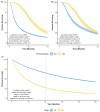Effect of stage shift and immunotherapy treatment on lung cancer survival outcomes
- PMID: 37285318
- PMCID: PMC10412408
- DOI: 10.1093/ejcts/ezad203
Effect of stage shift and immunotherapy treatment on lung cancer survival outcomes
Abstract
Objectives: Non-small-cell lung cancer mortality has declined at a faster rate than incidence due to multiple factors, including changes in smoking behaviour, early detection which shifts diagnosis, and novel therapies. Limited resources require that we quantify the contribution of early detection versus novel therapies in improving lung cancer survival outcomes.
Methods: Non-small-cell lung cancer patients from the Surveillance, Epidemiology, and End Results-Medicare data were queried and divided into: (i) stage IV diagnosed in 2015 (n = 3774) and (ii) stage I-III diagnosed in 2010-2012 (n = 15 817). Multivariable Cox-proportional hazards models were performed to assess the independent association of immunotherapy or diagnosis at stage I/II versus III with survival.
Results: Patients treated with immunotherapy had significantly better survival than those who did not (HRadj: 0.49, 95% confidence interval: 0.43-0.56), as did those diagnosed at stage I/II versus stage III (HRadj: 0.36, 95% confidence interval: 0.35-0.37). Patients on immunotherapy had a 10.7-month longer survival than those who were not. Stage I/II patients had an average survival benefit of 34 months, compared to stage III. If 25%% of stage IV patients not on immunotherapy received it, there would be a gain of 22 292 person-years survival per 100 000 diagnoses. A switch of only 25% from stage III to stage I/II would correspond to 70 833 person-years survival per 100 000 diagnoses.
Conclusions: In this cohort study, earlier stage at diagnosis contributed to life expectancy by almost 3 years, while gains from immunotherapy would contribute ½ year of survival. Given the relative affordability of early detection, risk reduction through increased screening should be optimized.
Keywords: Early detection; Non-small-cell lung cancer; Novel therapies; Overall survival.
© The Author(s) 2023. Published by Oxford University Press on behalf of the European Association for Cardio-Thoracic Surgery.
Figures
Comment in
-
The non-small-cell lung cancer crisis: a worldwide need for radiomics-enhanced early detection solutions.Eur J Cardiothorac Surg. 2023 Nov 1;64(5):ezad367. doi: 10.1093/ejcts/ezad367. Eur J Cardiothorac Surg. 2023. PMID: 37930019 No abstract available.
Comment on
-
The Effect of Advances in Lung-Cancer Treatment on Population Mortality.N Engl J Med. 2020 Aug 13;383(7):640-649. doi: 10.1056/NEJMoa1916623. N Engl J Med. 2020. PMID: 32786189 Free PMC article.
References
-
- Henley SJ, Thomas CC, Sharapova SR, Momin B, Massetti GM, Winn DM et al. Vital signs: disparities in tobacco-related cancer incidence and mortality - United States, 2004-2013. MMWR Morb Mortal Wkly Rep 2016;65:1212–8. - PubMed
Publication types
MeSH terms
LinkOut - more resources
Full Text Sources
Medical



